Preface
Running the Miwok 100k was a pivotal experience in my 18 years of running—longest distance ever, hardest course, a new approach to training and preparation—and it almost didn’t happen.
Miwok is a classic, sought-after, visually stunning race that covers 62+ miles around the Golden Gate National Recreation Area and Mt. Tamalpais State Park in the Marin Headlands north of San Francisco. (If you want a brief report on the event and its top finishers, rather than this lengthy personal regurgitation, check out this news story I wrote for Trail Runner about it.)
For several years–ever since I crossed over from marathoning to 50Ks and a few 50-milers–I had my eye on Miwok but felt nervous about graduating to that distance. I’m a reluctant ultrarunner whose sweet spot remains somewhere between 26.2 miles and 50K. Five hours still feels like a mighty long time to run. The prospect of more than doubling that time on my feet for a 100K intimidated me even more than finding something glamorous to wear to the annual school auction. (Thank goodness Miwok fell on the same day as this year’s auction so I didn’t have to put together a getup for the “Great Gatsby” theme.)
But when I looked at my calendar last fall and realized I’d be in the Bay Area the first weekend in May, I put in my name for a spot. (About twice as many people try to get the 400 permitted spots available, so the race uses a lottery system.) I got in and spent the first four months of 2012 methodically building up toward it.
Two weeks prior to the May 5 event, I finally stopped denying a pain in the shaft of my second toe that radiated across the top of my foot. It started during Spring Break and got to the point in mid-April where I could barely run up a hill because the impact of striking and pushing off my foot hurt so badly. I knew I should rest it, but I wanted to get in my long runs to build confidence for the race, so I ran barely at all for a week and headed out on my final long training run on April 20 of 7.5 hours, which covered about 37 miles. My foot felt pretty fine and normal until about mile 30. Instead of feeling good about accomplishing that long solo run, I felt a double lack of confidence: If that run was so hard, how could I double it for a 100K? And if my foot hurt, wasn’t I setting myself up for serious injury that would sabotage my special summer running plans? (On calendar: attending Geoff Roes’ Alaska ultrarunning camp in late July and then doing the Grand to Grand multi-day ultra in late September.)
I took a day off and then went out on a 12-miler. The first hour, it was fine. Then at mile 7, it unmistakably started to hurt. I was screwed.
The next day (April 23) I went to Dr. Dave Hannaford, a longtime ultrarunner who’s widely regarded as one of the best podiatrists for runners. He zeroed in on the point of pain and delivered the news it probably was a stress fracture. He said there was a 50 – 50 chance the injury had not progressed to the point of really cracking the bone (to which I wondered, is the glass half full or half empty?), but I was on a path of stressing and damaging the tissue so much that the tissue’s reaction would fracture the metatarsal.
Here’s what I learned about stress fractures: They start as an inflammatory response to help heal a bone that’s getting damaged by pressure or overuse. But if the stress on the bone continues rather than alleviates, then the inflammation progresses to the point where swelling or bleeding separates the coating of the bone from the bone. Then the outer layer of the bone becomes damaged, and a tiny crack develops. The crack grows and can turn into a true fracture—the kind that forces runners to hobble around in a Velcro boot, foot immobilized, for a couple of months.
I was fortunate to catch it early, he said, and we needed to stabilize my floppy forefoot’s overpronation to get the pressure off the second toe. He molded some orthotics into my Brooks Cascadias and gave me a yellow light of caution about running Miwok. I could try it, he said—there’s a chance, if I rested in the twelve days remaining, and ran with these orthotics—that my foot would be OK. “But if you feel pain out there, you need to bail on the run,” he said.
I spent the rest of the week icing my foot, resting, losing confidence in my fitness level even though I rode a stationary bike, and seriously debated whether Miwok was worth it. I didn’t want to be out on the course worrying the whole time. Inevitably I would feel some level of pain on the course—strong discomfort is part of the experience—and I didn’t relish the prospect of mentally debating, “Is this good pain or bad pain?” for 62 miles. What if it started to hurt halfway and I dropped out and further damaged it in the process of walking/limping to an aid station? The whole thing sounded like a lose-lose prospect.
I made up my mind not to run the race and resolved to enjoy the weekend up there anyway, since we had rented a beach cottage near the start/finish area. I actually got excited about not running Miwok. What a lovely get-away weekend: I’d support my runner friends by cheering them on at the aid station and finish line, I’d spend time at the beach with my kids, and I’d focus wholly on healing and getting better so I could start the summer training cycle A-OK.
A few days later, I ventured out on a test run. One mile into it, I wanted to run! My legs felt zippy and foot felt fine. Five miles turned into ten miles. After months of training, how could I miss Miwok?! I changed my mind again. The race was back on.
Race Day
Miwok fell three days before my 43rd birthday, and I treated myself to an early birthday present of a cottage rental at Stinson Beach the night before and night after the race. Whereas most runners had to navigate a dark, winding road through the Marin Headlands in the middle of the night to get to the start area between 4 – 5 a.m., I found an adorable little house easy walking distance to the starting line. It made me so happy. I had my pre-race meal of whole wheat spaghetti and sweet potato and went to bed early while Morgan and the kids stayed up soaking in the fabulous hot tub that came with the place and watching movies. I set the alarm for 3:30 a.m.
The event’s starting location in Stinson was a big change this year, part of a radically revamped course that runners’ GPS watches would record as slightly long (approx 63.5 miles) and extremely hilly (approx 13,000 ft. elevation gain). Race Director Tia Bodington changed the start/finish from Rodeo Beach because the old location is undergoing habitat restoration. She also changed the first third of the course since the old aid station at Pan Toll was inaccessible due to new regulations that prevent runners from crossing the highway there. Consequently, runners climb straight up to the ridge from Stinson, run an out-and-back north along Bolinas Ridge (dropping down around Mile 12 to an aid station along Bolinas/Fairfax Road), then back down to Stinson on the steep, technical Matt Davis Trail around Mile 25. (The elevation chart below is slightly off; the big dip down at Mile 23 actually comes a couple of miles later.) This made for a double-humped monster marathon to start the day.
I left instructions for Morgan and the kids to crew for me when I passed through Stinson for a second time at the marathon mark, and I hoped my foot would feel well enough to continue past that point to tackle the 35-plus miles beyond it. I resolved to gauge my pain on a scale of 1 to 10 and drop out only if the foot pain progressed beyond “talking to me” with mild discomfort or dull aching (2 – 4 on the scale) to a 5. I knew that seeing my family at the Stinson aid station could be a powerful incentive to drop out—why not call it quits after about five hours of running and enjoy the rest of the day at the beach with my family?—so I told my kids, “Tell me not to be a quitter! I will rationalize dropping out, so talk back and tell me to keep going!”
I experimented with some new gear for Miwok: a simple Nathan Race Vest with pockets rather than a hydration pack, because I didn’t want to refill a hydration bladder, and only one hand-held water bottle to start. I love the new lightweight vest. In my pockets and drop bags, I packed my favorite things: Nuun electrolyte tabs,
Honey Stinger waffles
and Bonk Breakers.
My plan was to pick up a second hand-held bottle when I saw Morgan at the Stinson aid station. I wasn’t sure what I’d really need in terms of gear and food, since I’ve never done an ultra this long, so I went overboard with the preparation. Blister kits, fresh socks, sunscreen, iPod, fresh shirt—I had it all. Except for one thing.
Runners are required to start with a light because at 5 a.m. it’s still dark, in spite of the full moon. I didn’t want to bring my high-quality headlamp (the Black Diamond Spot) because I didn’t want to have to carry it for several hours before being able to hand it off to Morgan. Tia, the race director, recommended carrying a cheap flashlight that can be dropped at the first aid station, mile 6, and then all those flashlights get donated to the local fire station for giveaway. Sounded like a good plan to me. I used the flashlight to illuminate my walk from the cottage to the start area.
I got to the start with time to spare, hung out with a few runners I know, and waited for 5 a.m. to approach. All of a sudden myself and about 350 others were off and running, circling the parking lot and climbing the side streets of Stinson’s village on our way to a trailhead. I felt fine, relaxed and happy to connect and chat with my Tahoe friend Gretchen Brugman, whom I met at American River 50 after she blazed by me and shouted “Pigtail Power!” (We braid our hair the same way.)
About a half mile into the race, we funneled into a steep and rocky single-track called the Willow Camp Trail that climbs from near sea level to about 1800 feet in a mere two miles. And that’s when the batteries in my cheapo flashlight decided to die. Oddly, I wasn’t terribly concerned. I figured the lack of light would force me to go more slowly and carefully up the hill for the kind of conservative start I’d need for the long day ahead. I tucked myself behind runners who had working lights. One of those runners recognized me and said hello. It was Shahid Ali, someone I met while running with the Rogue Valley Runners last summer during our visit to Ashland. Reconnecting with Gretchen, Shahid and others while following their lights gave me the warm-fuzzy feeling of being part of a community that would carry me along the long and tortuous trail.
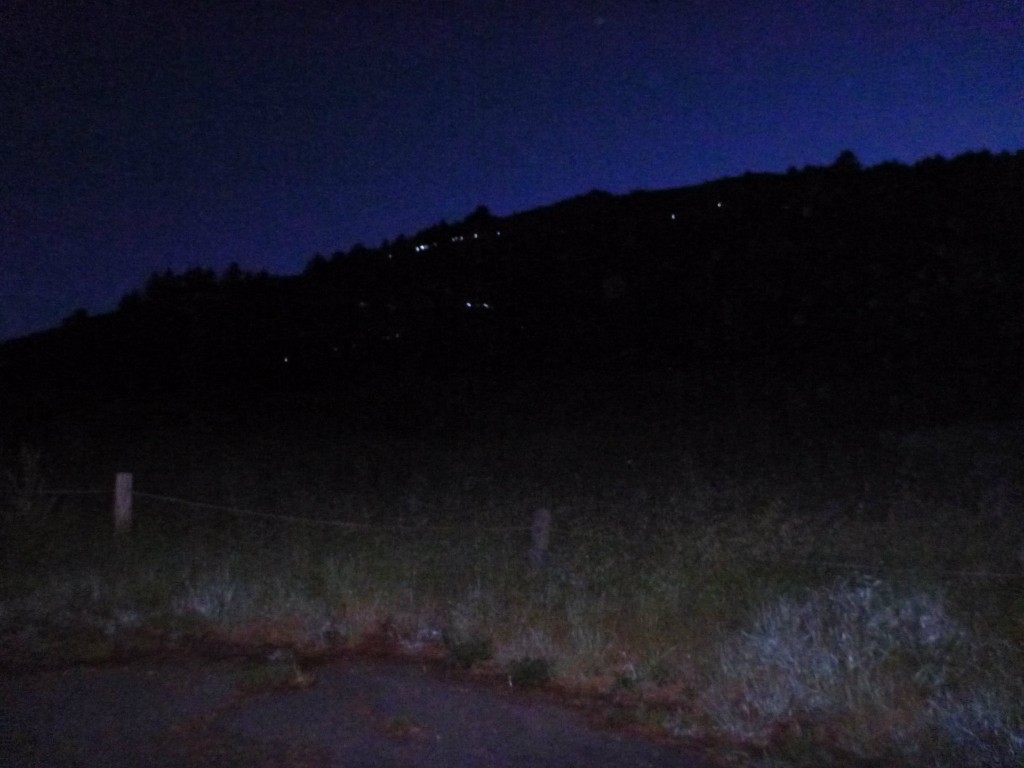
A view of the first climb, on Willow Camp Trail, ascending nearly 1800 feet in a couple of miles in the dark. The specks of lights are runners' headlamps. (photo courtesy of Tanford Tahoe via Facebook)
The payoff for that climb in the dark was a pink-tinged sunrise on a grassy hillside so pretty I almost didn’t mind the awful trail underfoot. Imagine having a Julie Andrews Sound of Music moment—because the top-of-the-world lush scenery above Stinson is almost as beautiful as the Alps—but the troublesome trail keeps harshing your buzz because it’s barely twelve inches wide, slanted 45 degrees and riddled with gopher holes that want to swallow your ankles. Plus, knee-high grass hides the tripping hazards and pokes you with thistles. My feet stumbled along, painfully rolling around my shoes—but I told myself it was OK because my whole foot hurt from sliding sideways, not just the injured spot. Still, a mere four miles into this 63-mile journey, I was thinking, WTF?????
Then I reached Bolinas Ridge at the 10K mark, and everything was copacetic. Ah, Bolinas Ridge—a fire road just made for runners. Gentle rolling hills, soft piney underfoot, shady redwoods … I could run for hours on that out-and-back. I found my mojo and ran on, no pain, just smiles.
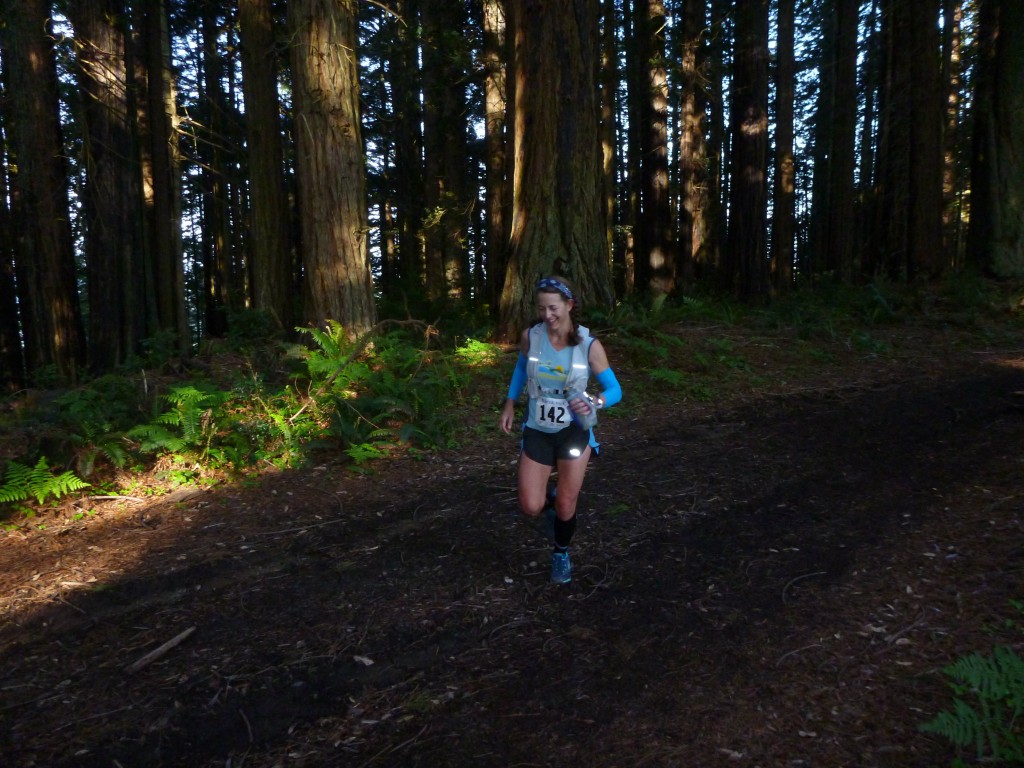
That's me running on Bolinas Ridge, the easiest, most pleasant stretch of the day. I'm not hopping on one foot or doing a jig--it just looks that way. (photo courtesy of Tanford Tahoe via Facebook)
The out-and-back on Bolinas Ridge (Miles 6 through 19) gave me ample time to reflect on my goals as well as survey the other runners. My number-one goal was to finish, period: to persevere by cultivating the endurance and patience needed to keep going all those hours in spite of fatigue. I needed to know I could push through discouragement and doubt to reach the finish, to build my confidence for doing the multi-day Grand to Grand Ultra this September. To increase the chances for finishing, I deliberately ran conservatively and non-competitively, viewing the course itself as my only competitor and thinking of the other runners as my friends and helpers.
But, I also knew from past experience at 50-milers that I needed a plan and mini-goals of reaching aid stations by targeted times. When I ran the North Face Endurance Challenge last December, my goal “to just finish” backfired insofar as it undercut my motivation and made me feel aimless on the course. For that reason, I studied past years’ Miwok finishing times and aid station splits of other runners I know who run close to my pace at shorter races. I memorized a range of time when I hoped to hit each aid station. Based on these past Miwok times of runners I know, I came up with my secondary goal: Break 12 hours. I knew lots of people who broke 11 hours on Miwok in past years, so the sub-12-hour goal seemed reasonable. I actually hoped to get in around 11:30, but I’d play it safe.
Surveying the runners, I developed my third and least important goal: to crack the Top 20. I knew ten to twelve of the female runners in the field who are far and away faster and more experienced at ultras than I. But there was a second tier of about a dozen women I would place myself among, plus a lot of unknowns from around the country. Of the 350 starters (more than 400 entered but only 350 actually started), roughly one-quarter were women. Finishing Top 20 became my fun goal, like icing on the cake.
Approaching the Randall Aid Station, which is the mile 12 turnaround point on Bolinas Ridge, I could see the top male and female runners coming back. Sure enough, the top women were the ones I expected. I tried to count all the women running toward me as they came around the turnaround and realized I was somewhere around 13th or 14th place.
I settled into a rhythm while chatting business with speedster entrepreneurial Silicon Valley guy Adam Blum, and then on the second pass-through of the Bolinas Ridge Aid Station (Mile 19), I discovered a soft and salty delicacy so surprisingly satisfying, I ate perhaps one too many: hummus wrapped in tortillas. I felt fortified for the return on the narrow, gopher-holey Coastal Trail and ran hard, looking forward to seeing my family at the Stinson Beach Aid Station.
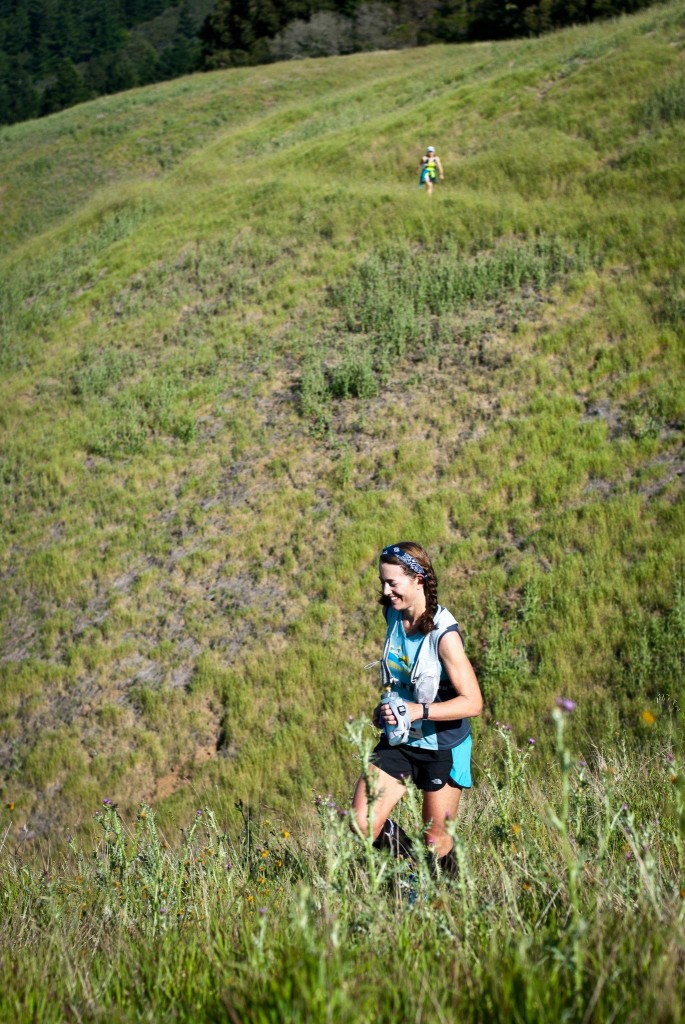
On the Coastal Trail around Mile 22. Both this photo and the one below are courtesy of Brett Rivers, who's a great runner as well as photographer and very generous to be out on the trail photographing runners.
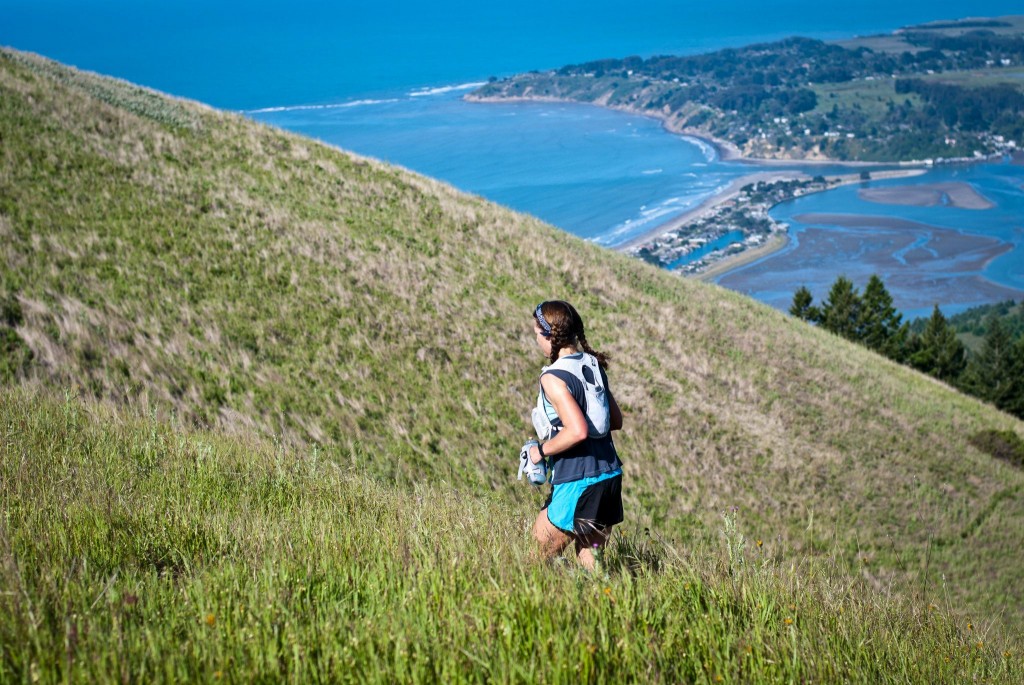
Brett's photo of me above Stinson. From that ridgetop, we had to bomb down about three miles to the aid station at Stinson Beach.
A hairpin turn onto the Matt Davis Trail evoked flashbacks from the North Face Endurance Challenge last December, when I really sucked on this highly technical, steep downhill, which has tripping hazards of branches, rocks and built-in steps nearly every five feet. Seeking redemption, I pushed myself and hammered down that hill. Good news: No pain in my second toe! Bad news: My lower back, hips and quads felt unusually stiff and achy. Plus, my gut rumbled and emitted gas, the first hint that I’d turn virtually volcanic several hours later.
I told Morgan and the kids I’d reach them about 4 hours, 45 minutes into the race, and I was late, foreshadowing several times that day I’d approach an aid station feeling late and wondering why I was so off pace.
Morgan, Colly and Kyle greeted me enthusiastically. I was so happy to have a crew there, with a chair and my gear all ready. Morgan and Colly jumped into action to attend to my every need as expertly as ER nurses. Kyle, however, had his mind on the soda at the aid station table. He morphed into Bart Simpson, asking, “Can I have some Mountain Dew? Can I have some Mountain Dew? Mom, why can’t I have some Mountain Dew?” I felt on the verge of turning into a wife and mom who wants to hear details about her family’s day and reprimand her son’s manners. Help! I had to escape that trap—I had to get out of there! After lingering long enough to re-sunscreen, re-lube and refuel, I thanked them, grabbed my iPod and extra water bottle, and ran away as fast as I could.
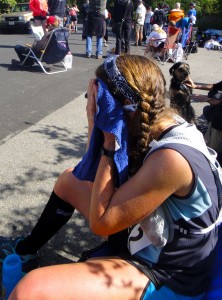
Ah, that felt good! At 10 a.m., the cloudless sky made for a warm day. I put on a fresh layer of sunscreen and got my visor out of the gear bag.
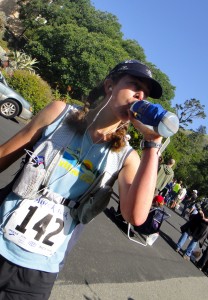
"Beware the chair," I kept telling myself. I spent a good five minutes or so at the aid station and felt myself slipping into comfort and complacency. I had to get out of there, quick!
I would have kept running, but the Dipsea Trail’s climb to Cardiac slowed me to hiking up those innumerable steps. I sagged. I knew I would. In each of the three 50-milers I did previously, I experienced the lowest low points somewhere between miles 27 and 33. This was no exception. In spite of the adequate calories and hydration in my system, and in spite of the good tunes on my iPod, I couldn’t shake feeling weak and stiff with incredibly tired feet.
I climbed up and over the 1400-foot summit on the Dipsea (the third of eight major hill profiles on the course) and tried to stride out on the shady, relatively flat two miles along the Redwood Creek Trail heading into Muir Beach. But I felt discouraged and cranky. My plan had been to reach Muir Beach (mile 33.5) in 6 to 6.5 hours (timewise, that meant 11 – 11:30 a.m.), but I knew I’d miss that window.
I reached Muir near noon. My friend Christine Chapon was working the aid station, and she knows me well enough to tell I wasn’t a happy camper. She refilled my bottles while another helper put a damp sponge on the back of my neck to cool me off. I had started overheating in the direct sun. The temperature, in the high 70s, was pleasant but warm for all-day running. I bellyached to Christine and went to the toilet for a long bathroom break. I knew I needed these lengthy aid station stops to pull myself together and regain strength, but I also knew they were putting me further behind my sub-12-hour goal.
Hiking out of Muir Beach—and it is a straight-uphill hike—I shimmied my shoulders and shook out my arms. I was getting my time goal off my back, shaking off the burden I placed on myself. I told myself, Just do the best you can with whatever the trail gives you and keep going. All that matters is finishing. You will NOT drop out.
I alternated fast hiking and jogging up the 1,000-foot wall that rises behind Muir Beach and crests over Tennessee Valley. I had the wide-open, sunny fire road to myself, good music in my ears, and I powered up the hill feeling fresh for the first time since Bolinas Ridge. Then I ran hard and strong down to the Tennessee Valley aid station at Mile 38. How could it be that I felt better and stronger running downhill after 35 miles than I did three hours earlier? I stopped briefly at the aid station and headed up Marincello Road, another steady climb. I passed several runners on this stretch as they walked and I ran. Who knew I’d feel so good at Mile 40?
You can probably guess what happened next. As the saying goes, “There will be highs and there will be lows, and neither will last very long.” I concentrated so much on running strong up Marincello Road that once I got to the top, I was beat. Plus, two or three songs kept repeating on my iPod. I’d fast forward to a fresh song, and then an old song would repeat. The shuffle function wasn’t working, and it was pissing me off. I turned my iPod off and grumped.
Up so high, straddling the ridge between Sausalito and Rodeo Valley, I looked down at the Golden Gate Bridge and San Francisco skyline and paused to take it all in—to feel accomplishment for the 40-some miles. I ran steadily again, passed through the Mile 43 aid station and ate more hummus-tortilla wraps, and then began the plunge down to Rodeo Beach.
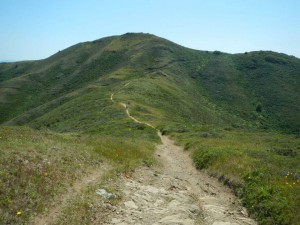
A view of the SCA Trail above Rodeo Valley, around mile 42 (photo courtesy Irving Bennett via Facebook)
Just before reaching the bottom near Rodeo Beach, the course offered up an unwelcome surprise. We had to hang a left off the fire road and bushwhack through a single-track trail with waist-high grass. I cursed the unexpected hilly stretch and the annoying grasses and branches that tripped me up. Finally the course dumped us out in the open again by the youth hostel (another opportunity for me to take an extended bathroom break. I nearly took a nap in the cool refuge of what was truly a “restroom”). Then I ran down to the beach and actually enjoyed running across the sand. Maybe it was because the beach-goers lying on their towels regarded us runners as freaks, or maybe because the sand was so soft and the crashing waves so refreshing to the eyes and ears.
From there, I was on familiar territory, having raced several 50Ks that start at the Rodeo Beach visitor center. I was mentally prepared for the 800 foot ascent that goes straight up from the beach, but physically I was falling apart. The climb was harder than I ever remembered. Clusters of tourists and day hikers clogged the trail and the narrow steps that climb the hillside as steep as a ladder. I grunted, “‘Scuse me, ‘scuse me, thanks” as I elbowed past them, but each word was so garbled from my panting, and punctuated with my belches that blasted like a fog horn, that they might have moved aside more from fear than politeness.
At that point, nearly delirious from exhaustion, one thing helped me focus and stay motivated more than anything else: The prospect of my friend, Suzy Noe Kisylia, waiting to run with me at Tennessee Valley (Mile 50.5). Runners were allowed to pick up pacers for the final half-marathon stretch of the event. I had been skeptical that I would need someone to run with me—after all, if I had gone 50 miles, couldn’t I finish it all by myself?—but struggling to the top of the last ridge before meeting Suzy, I felt immensely grateful she would be there. Except, I also felt guilty for being so late. I had told her to be there by 2:30 p.m. (9 and a half hours into the race), and I was going to arrive about an hour after that. I crested the ridge and forced my legs to regain their turnover for the long, steady downhill to Tennessee Valley. I felt nauseous and achy all over—and then two big blisters diverted my attention. Why those blisters decided to blow up then and there, I don’t know, but they did. At least it’s not my so-called, not-ready-for-prime-trime stress fracture, which kept quiet all day, I reminded myself.
I came into Tennessee Valley, Mile 50.5,with Suzy cheering and professing she didn’t mind the long wait. I waved and shouted, “Bathroom, stat!” and ran past her to the toilets. The aid station looked like an emergency evacuation meeting point with gear bags littered everywhere, listless pacers waiting for their runners to come in, volunteers working triage, and runners wandering around hunched over like patients clutching the handrails in hospital hallways. I elbowed my way ahead of five others to be at the front of the Porta-Potty line and knocked rudely on the locked door to let the person inside know I HAD to go. Then the door opened, and I had an awkward moment of facing the guy who happens to be the boyfriend of my close friend whose ex-husband is one of my best friends. Suddenly, in spite of my severe gastrointestinal distress and exhaustion, I felt I had to make small talk and pretend everything was perfectly fine to normalize the situation. He must have sensed my predicament because he graciously held the door open for me and cut the conversation short.
I did my business and then took care of the second order of business: wrestling off my compression sock to bandage the blisters. Getting the compression sock back on my sweaty calf is not an experience I want to repeat. I also took off my vest and stashed it in my drop bag so I could run as lightly as possible. Finally, after more time than I ever imagined I’d waste at an aid station, I told Suzy I was ready to go and finish this thing.
Running with Suzy was great. She was like a nurse in a labor and delivery room who listens sympathetically and distracts with small talk while I, the madwoman in labor who has lost all inhibition and sense of propriety, alternated between complaining, babbling and blurting life stories. She reacted cheerfully when I bossed her around, telling her to run ahead or behind or slow down or speed up as we climbed the ridge back toward Muir Beach and snaked along the scenic Pirates Cove trail. She was the best.
We passed through the Muir Beach aid station (mile 54.5) and I saw my friend Christine again, who generously told me I looked better than I had looked the first time through at mile 33.5. Suzy and I fortified ourselves and embarked on the last flat, easy stretch, the Redwood Creek Trail. We caught up to Shahid again and chatted before passing. I knew that if I was running near Shahid, I was still doing OK.
The last spike on the elevation chart—the 1400-foot climb up Cardiac—is difficult to put into words. Imagine having the stomach flu, not sleeping for three days and then trying to cross Africa as part of a wave of destitute refugees. It wasn’t that bad, but those are the types of images that crossed my mind as I wallowed in self-pity. My gut audibly rumbled while waves of nausea rose up in my throat. My hiking devolved into an arthritic old-lady shuffle. We hooked up with some garrulous guy from Honolulu who chatted amicably with Suzy while I kept quiet like a hungover tagalong who wishes they would turn down the volume. I looked at my watch and realized we were well into the twelfth hour and still had four or five miles to go. I thought I would be done by now!
Meanwhile, back at Stinson Beach, my family waited … and waited … and took pictures to fight boredom while wondering where the heck I was.
I vowed to ditch that Honolulu guy and get the hell back as fast as I could. You know, when the going gets tough, the tough get going, and all those cliches that actually help at moments like that. I started running. Really running! I ordered Suzy to get behind me because I didn’t want her to slow me down. My cement-like legs limbered up. My feet took the abuse. We crested Cardiac and started the luge-like descent through redwoods and down stairs. It was around 6 p.m. and I felt sorry for all the runners behind me who’d have to run this part in the dark, without a headlamp, if they too were having a slower-than-expected day (as most were).
In the final mile, I even ran up the last not-so-little hill. I dumped my two water bottles about an eighth of a mile from the finish so I could run hands-free and sprinted all out when I spotted my family cheering for me. I made it! Thirteen hours, eight minutes.
After all those hours and miles, I felt surprisingly energetic. My feet were killing me, my legs quivered, but part of me felt as though I had arrived late to a party and wanted to make up for lost time by walking around and talking to everyone. I was so happy and ready to celebrate!
As soon as I started talking to others, I felt better about my time. Everyone said the new course took one to two hours longer than expected to finish. Dave Mackey, the course record holder, won the race in 9:14, which was about 1 hour, 20 minutes slower than his fastest prior time at Miwok.
All in all, this was a momentous day for me and a valuable learning experience. I practiced patience, pushed through deep discomfort and realized some things I need to do differently in terms of foot care, gear and nutrition to make it through the ultra in September. Most of all, thanks to the camaraderie on the course, and in spite of—and partly because of—all the difficult times, I had so much fun!
In a field of 350 starters, I was one of the 264, or 75 percent, who finished. I was 81st among all the finishers.
And among the women? 19th place!
Endnotes
If you want to see what the trail was like for the front runners, check out this great video by The Endurables:
Many thanks to the photographers. Check out Glenn Tachiyama’s gallery here.
I am so grateful to RD Tia Bodington and her team of volunteers. The volunteers motivate me to volunteer, which I’m doing tomorrow by sweeping the Ohlone 50K course. Christine Chapon, Laurie Abrahamsen, Victor Ballesteros, Gary Gellin and all the dozens of other volunteers, you were so great!
Suzy: I owe you big time. You’re a terrific pacer.
And many, many thanks to my crew. They had a tiring day, too!

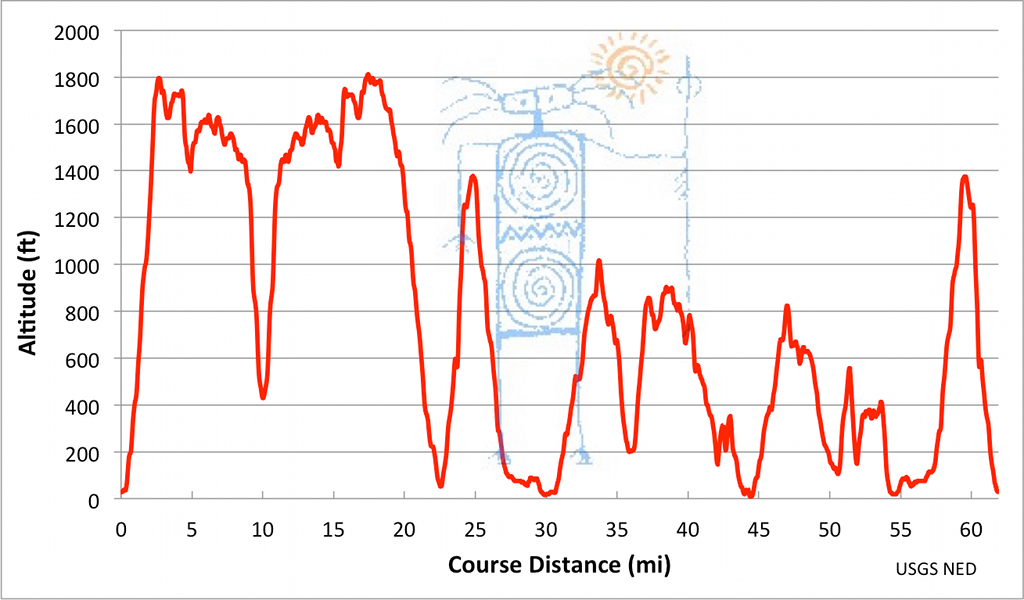
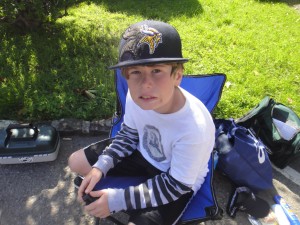
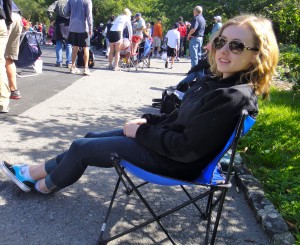
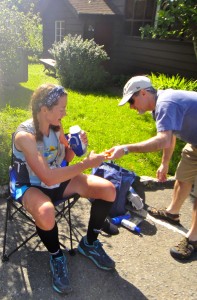
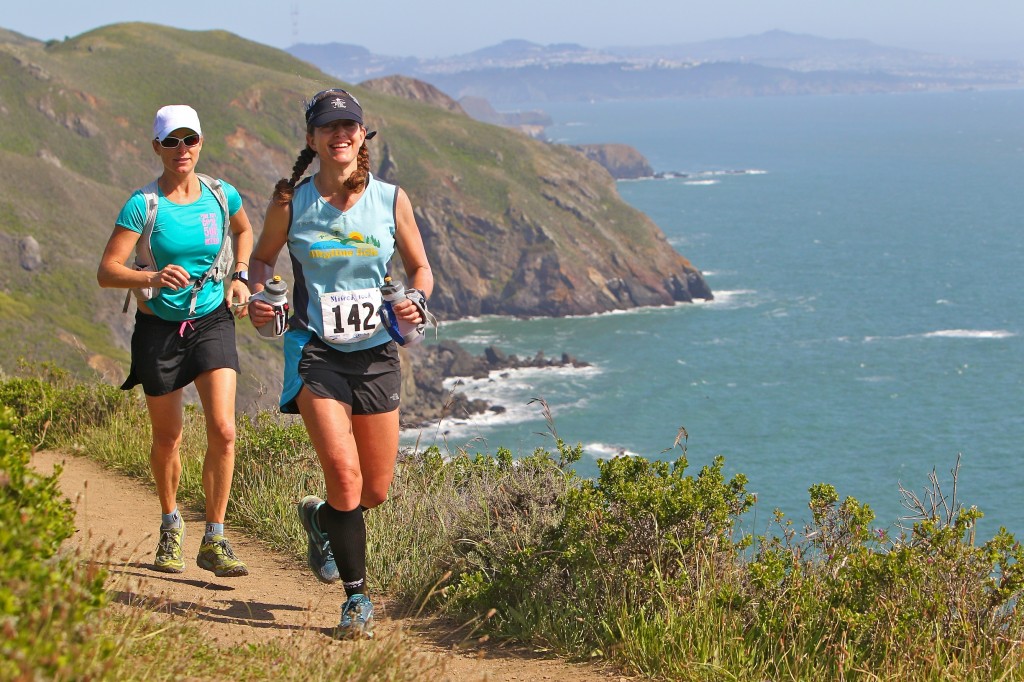
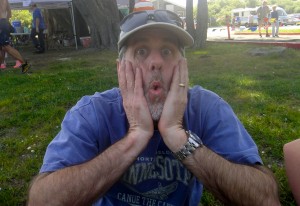
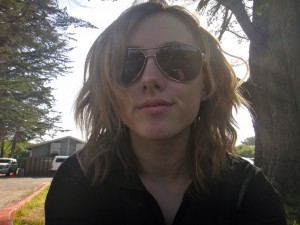
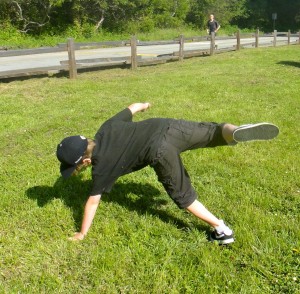
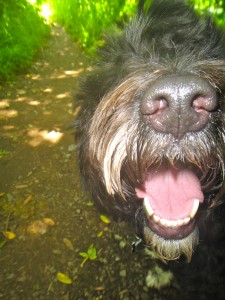
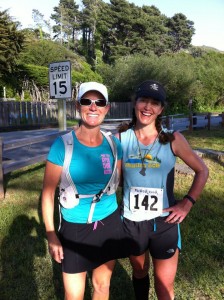
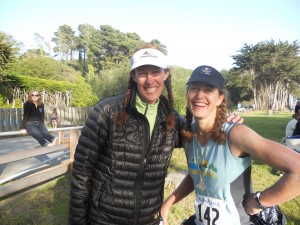
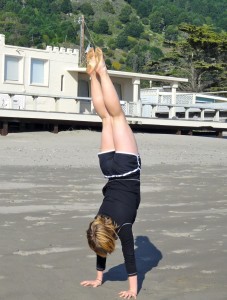
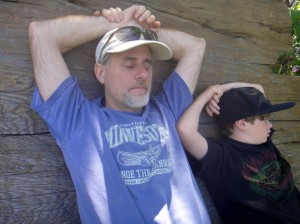
Great job out there, Sarah! You are tough! I’m so glad your toe was OK and “bathroom troubles” are such a pain. Maybe next time, avoid the humus? Seeing all the runners out there made me want to be out there, too. I’m thinking of running Miwok again next year.
I was volunteering at the Rodeo Valley Aid Station (mile 43), put on by my running club, and I happened to just catch you crossing the road there and I snapped a picture. (It’s yours if you want it.) My wife was wearing the inner tube (funny!) and holding traffic for you.
https://plus.google.com/u/0/photos/111729868996863956533/albums/5740770111184368017/5740771599423346514?authkey=CK3fu7jzkKL55gE
Awesome, thank you Ron! You and your wife are so generous with your time to be out there.
Yeah, the hummus is probably a mixed blessing.
That’s a funny pic. Not sure who looks stranger, your wife in her swim tube or me.
Sarah, this race report is adorable, and you’re hilarious. And I love that you used the word “garrulous” in a race report. Sounds like a great training day, especially from the mental standpoint of seeing what your body can do when you kind of come to peace with running through discomfort. You’re running the Grand to Grand stage race? Awesome! Well, you’ll put that skill to work there, for sure. 😉 CONGRATS!!!!
Great job! Great race report, too!
Sarah,
Congrats on another great race and a wonderfully readable report–though that observation early on (“strong discomfort is part of the experience”), while undeniably true, makes me worry about my sister’s masochistic tendencies! Seriously, though, this sounds like it was both a great race in and of itself, and a real confidence booster for the G2G ultra later this summer! Loved the shots of Morgan and the kids!
You did great out there! That course was brutal! And it doesn’t really surprise me all that much with how well you did. You are an amazing runner! And I think you still have a lot of untapped potential. 19th woman in your first 100K. With every race, I think you’ll keep getting stronger and faster. Maybe if you focused on trails (and not that little road marathon excursion), you would have done so much better here! And with each little rough patch that we overcome, I think we also become stronger mentally. I think we both could use a little redemption on this course. Congrats again! And I love how you get to spend so much time with you family before, during, and after your race! Someday, I hope I can drag my family out there!
Terrific report, Sarah! I could tell when we saw you on your return through Tennessee Valley that you were in uncharted territory. Now you’ve got a true sense of what the longer ultras are like. (Our friend Craig, a very experienced ultrarunner, says this year Miwok had more the flavor of a 100-mile race than a 100K.) Great job holding it together when times got tough. Things DO almost always get better again.
Oh, and your description of the encounter with Chris in the porta-potty was too funny!
I finally posted my own report and can reward myself with the treat of reading yours. 🙂 Great stuff!
Awesome job out there, Sarah! This was really a tough one for a first 100K, and you did great! I think you really had the right mindset, and you should be proud of this performance.
It was cool to read your report and see how you felt at various parts of the course. I was not stoked on that overgrown singletrack just before Rodeo Beach either!!
Good luck with the rest of your training this summer, and I’ll see you in Silverton!
Sarah, that was awesome. The best part is that you had so much respect for the distance. Too many people lately jump into ultras to have it checked off the list, without properly training and taking intermediate steps with shorter stuff. This was your pinnacle. Sorry about the toe and the whole she-bang of the stress fracture – one I know too close and personal. Take care of yourself! And congrats.
Congrats on another great race and a wonderfully readable report.
Matt.
What an achievement and a great write up I also enjoyed the video at the end – set Free, help capture some of the terrain and views………..
Fantastic write up. Such a wealth of information for anyone interested and or attempting to delve into the world of Ultra. I am now absolutely terrified and hugely excited to dip my feet in to this mad occupation.
Hope to see you on the trails.